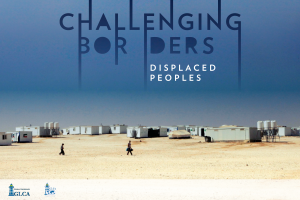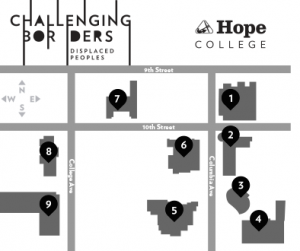
See this image here above. Maybe you’ve encountered it on your way through the first floor of DeWitt, or in the first floor rotunda of Martha Miller, or by the psychology department in Schaap. Maybe you’ve looked at it and thought, “That looks interesting.”
It is. Slow down.
See the image above. Maybe you glanced at it on your way into the dining areas of Cook and Phelps, or in the lobby of DePree and Jack Miller. Maybe it caught your eye by the circulation desk in Van Wylen Library, or just inside the front door of Kruizenga. Maybe you’ve looked at it and thought, “That must have something to say.”
It does. Look closer.
See the image above. It is at all of those nine locations, providing an atypical classroom through a QR code that will teach you. Maybe you’ve looked at it and thought, “That seems like a game changer.”
It can be. Stop.
Get out your phone, scan the code, and learn. The project, “Challenging Borders: Displaced People,” has much to teach you about those whose lives have experienced disruption and disorder due to immigration, climate change, the refugee crisis and mass incarceration. And the disciplines of art and English and science and psychology and communication all converged to do so, crossing interdisciplinary boundaries in order to challenge you about the ways you view borders — domestic or international — and the people who are affected by them.
The best way to take in the “Challenging Borders” project is actually do that: challenge borders by walking the project in its entirety. Traipse to every poster on campus, cross streets, open doors, enter rooms, search hallways, and you’ll feel measures of boundaries as you do.
Funded by a $16,000 Global Crossroads Initiative grant sponsored by the Great Lakes College Association (GLCA), of which Hope is a member, “Challenging Borders: Displaced People” is an interactive, 3-5 minute audio-visual diaspora in those campus locations listed above. Nine faculty/student collaborative projects were selected from across divisions to participate so when you scan each poster’s QR code located on its lower right corner, you’ll engage in interdisciplinary sensory and factual uploading.
“The days of us living in our disciplinary silos are over,” says Dr. Heidi Kraus, co-coordinator of the project. “This project is a great example of disciplines converging. We have people from chemistry, from art, from English, from psychology, from communication all talking together. We are breaking down borders even between our own disciplines with this project.”
The best way to take in the “Challenging Borders” project is actually do that: challenge borders by walking the project in its entirety. Traipse to every poster on campus, cross streets, open doors, enter rooms, search hallways, and you’ll feel measures of boundaries as you do. And it’s a good way to get in 2,481 steps on your day, too. It’s also a good way to encounter multiple perspectives on the complex issues of migration and displacement gripping our nation and world.
“When we thought of challenging borders, we were interested in the idea of movement and bringing a physicality to this,” explains Kraus. “We wanted the feel of borders and of crossing those and walking to spaces. So the idea of a physical diaspora came to fruition.”
“It is like an image in a kaleidoscope: each piece itself is beautiful, but when you look at all of them together, you feel how all of them create something new and even more beautiful.”
“After I saw all the projects, it surprised me how different all of them were but at the same time how all of them complemented each other,” says Dr. Berta Carrasco de Miguel, co-coordinator of the project. “It is like an image in a kaleidoscope: each piece itself is beautiful, but when you look at all of them together, you feel how all of them create something new and even more beautiful.”

You can start at any one of the nine buildings shown on the map above (and identified on a list below). Then think of tackling your walk across campus borders to every project as strolling in a circle, rather than a rectangle, and you’ll begin to feel encompassed and safe inside Hope’s finely groomed green areas and well-kept buildings, a fraught juxtaposition for the images of marginalization and disenfranchisement you’ll soon encounter. As you watch and hear each project depict those who have been displaced and excluded, a needed unease settles in and with it comes the most needed emotion of all: empathy.
So, slow down, look closer and stop to challenge borders, but know this: You won’t walk away the same.
“I hope the Hope community understands the complexity and importance of these topics and gets a feeling of closeness to the main characters of these videos,” adds Carrasco de Miguel.
If walking to every poster in one fell-swoop isn’t within your end-of-the-semester time budget, then take in one project at a time when you happen to be in each building. Slow down, look closer and stop to challenge borders, but know this: You won’t walk away the same.
- The Complexities of the Immigration Experience — Prof. Deb Van Duinen @ Jack H. Miller Center for the Musical Arts (Lobby)
- A Voice to Balance the Negative Rhetoric About Refugees — Prof. Jayson Dibble@ Martha Miller Center (First Floor Rotunda)
- What is in a Name? Hispanic or Latino? — Prof. Berta Carrasco de Miguel @ Kruizenga Art Museum (Entry Area)
- Finding Truth in Fiction — Prof. Susanna Childress @ DePree Art Center (Lobby)
- Walking Gregory’s Neighborhood — Prof. Tori Pelz @ DeWitt Center (North Hallway)
- It Takes a Village, But Will There Always Be One? — Prof. Joshua Kraut @ Phelps Hall (North Dining Entrance Area)
- What Would You Do? — Prof. Scott VanderStoep @ Cook Hall (South Dining Entrance Area)
- Fitting In: Our Quixotic Endeavors in a New Home — Prof. Tatevik Gyulamiryan @ Van Wylen Library (Circulation Desk Area)
- Climate Change and Global Displacement — Prof. Joanne Stewart @ Schaap Science Center (First Floor, Near Psychology Offices)


A beautiful write up, Eva. Thank you!
So well said!